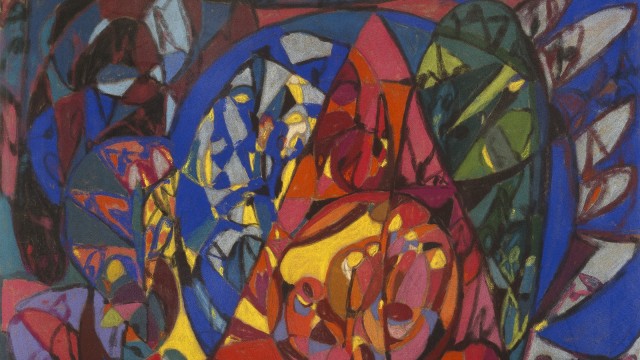
Works in the Collection
In 1901, at the age of 48, Adolf Hölzel published his first essay on art theory in “Ver Sacrum”, the elaborately designed journal of the “Vereinigung Bildender Künstler Österreichs” that was devoted to Art Nouveau. It was entitled “Über Formen und Massenvertheilung im Bilde” (On Form and Distribution of Mass in Pictures). In his essay, Hölzel takes a highly systematic approach to explaining the fundamentals of his concept of composition and already clarifies in the preface that while nature is indeed the best teacher, the main objective is to see it merely as a means for creating art: “First and foremost, in our studies of nature, and even when we aim at reproducing it faithfully, we will have to understand what truly matters in painting.” Hölzel first cites the dependency on the surface, the undeniable basis of artistic representation, which simultaneously refers to its specific requirements that must be taken into account when transferring a natural subject or artistic idea into a painting. The priority that Hölzel gave the surface is continued in the works of his students, for example that of Willi Baumeister .
Hölzel attached great importance to the knowledge and correct use of artistic means. These include translating the three-dimensionality of nature onto a two-dimensional surface in an effort to first distinguish what is essential for the composition of a painting from what is not; this is followed by the line, shape, and color, as well as knowledge of the way viewers look at a painting, that is the visual principles of perception and the sentiments they elicit in the viewer. To Hölzel, the objective of artistic depiction is to create a “pleasant and harmonious impression.” According to Hölzel, this objective is achieved by considering the known opposites when composing the picture plane, notably line and shape, light and dark, cold and warm, horizontal and vertical, hard and soft, big and small, as well as calm and restlessness. Hölzel attaches particular value to the understanding of the correspondences between defined shapes and the spaces that are created between them. They always constitute the respective composition and expression as “form figures” that are altogether interrelated. Hölzel concludes his essay with three illustrations that highlight the harmonious effect of “irregular” or, as Hölzel calls them, “ornamental shapes” to demonstrate that the basic geometric shapes of circles, triangles, squares, or rectangles, despite being constructively relevant, are less suited to this purpose.
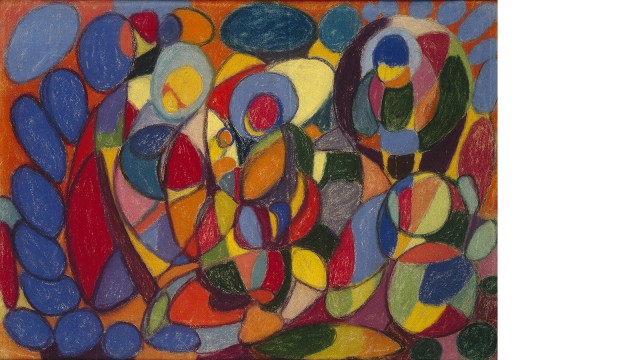
In his essay in “Ver Sacrum”, Hölzel essentially penned a manifesto on line-bound planar art as later shown by his pastel “Anbetung” (see above), for example. The painting consists predominantly of round and oval and colored compartments, some of which are further delimited by self-contained outlines. The fact that not only line and shape, but also color plays an important part in Hölzel’s work and theoretical reflections becomes apparent from the letters addressed to his former student from Dachau, Bettina Feistel-Rohmeder, between 1904 and 1905, as well as the essay entitled “Über künstlerische Ausdrucksmittel und deren Verhältnis zu Natur und Bild” (On Artistic Means of Expression and Their Relation to Nature and Image) that was published in the “Kunst für Alle” (Art for Everyone) magazine in 1905, the recorded notes from his classes at the Stuttgart Academy, as well as the speech entitled “Einiges über die Farbe in ihrer bildharmonischen Bedeutung und Ausnützung” (Some Thoughts on the Importance and Utilization of Color for Pictorial Harmony) he gave at the “Erster Deutscher Farbentag” of the Werkbund in 1919.
One of the basic ideas of Hölzel’s color theory contrasts the three-dimensionality of nature with a triad of color to be achieved in a painting, which is essential for creating a harmonious image and especially for its sentiment. After all, “art is and shall remain a matter of sentiment,” as Hölzel said in his speech in front of the Werkbund. It is due to Goethe’s color theory that Hölzel ascribed primary importance to purple for the creation of color harmonies. Both the eight-section and the twelve-section color wheels that Hölzel developed on the basis of this theory place purple at the top, with the warm spectrum always continuing to the right and the cold spectrum to the left. The twelve-section circle thus encompasses the colors of purple, carmine red, bright red, orange, yellow, yellow green, green, blue green, cyan blue, ultramarine, blue violet, and purple violet. Hölzel thus followed Wilhelm von Bezold and his 1874 publication “Die Farbenlehre im Hinblick auf Kunst und Kunstgewerbe” (The Theory of Color and its Relation to Art and Art-Industry), to which he made reference time and again. In the same fashion, he processed Schopenhauer’s color wheel of equivalence, which is based on the bipartite nature of the retina when viewing colors and implies that the perception of a color is always based on the perception of color pairs and their differing brightness. French chemist Michel Eugène Chevreul, who is considered to be one of the founders of modern color theory thanks to his discovery of simultaneous contrasts, is another author on the topic of color who was important to Hölzel.
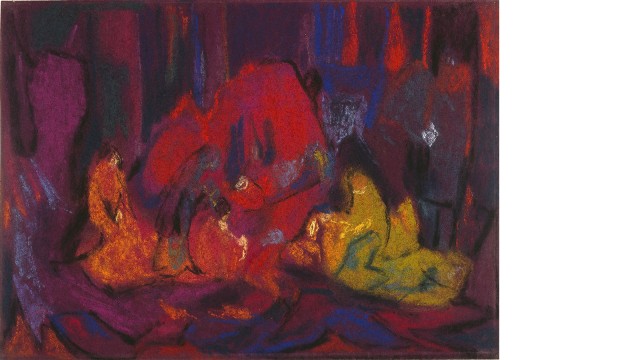
Based on the findings that were extensively studied and systematically prepared for teaching, Hölzel was able to derive numerous triads of color from the twelve-section color wheel that was primarily used for lessons: purple – yellow – cyan blue; carmine red – yellow green – ultramarine; bright red – green – blue violet; orange – blue green – red violet. Adolf Hölzel’s pastel “Anbetung” from the LBBW Collection (see above) shows the biblical motif of “adoration” with the harmonious effect gained from the color studies. Across the surface, Hölzel varied between different modulations of purple, blue, orange, red, and yellow green, and added individual spots of yellow as an accent. The adoration group is further highlighted and fleshed out by contrasts that are based on Hölzel’s artistic means of the “seven color contrasts”. The main contrasts used in this painting are temperature (cold/warm), quantity (distribution of the amount of color), and intensity (brightness of the colors).
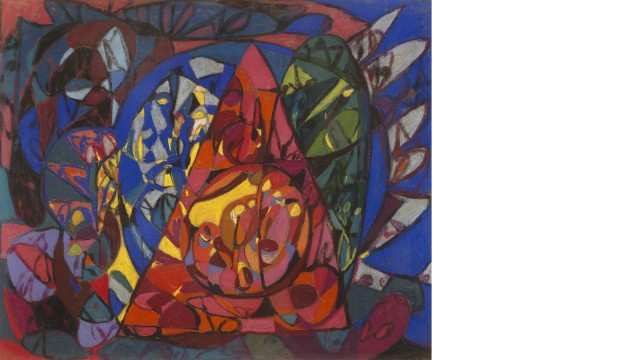
A third pastel in the collection, also entitled “Anbetung” (see above), is based upon the color and composition theory that was so essential to Hölzel. In this picture, the main group is slightly shifted to the right of the center, but framed by a triangle and with its warm spectrum of reds and yellows therefore clearly offset from its cold surroundings. In contrast to Hölzel’s other “Anbetungen”, there is the added contrast between calm and restlessness here, created by the shapes outside of the triangle moving outward while the ones within the triangle are aligned toward a central point.
The biblical motif of adoration appears numerous times and in numerous variations in Hölzel’s oeuvre since 1908/1909, causing the majority of researchers to assume that this biblical image is not to be interpreted in terms of the artist’s religiousness. It rather seems reasonable to assume that Hölzel must have greatly appreciated the image as a starting point for his reflections on theory and painting as it allowed him to work his way from the subject of adoration to a pure, abstract sentiment as the aim of art. Hölzel repeatedly dissolves the group of figures into various forms of ornamental shapes, a practice he eventually applied to four large designs of stained-glass windows. In 1914, he received the first commission for designing glass windows for the conference hall of the Bahlsen factory in Hanover. Between 1928 and 1929, he created three glass windows for Stuttgart city hall. Between 1932 and 1933, he completed the eight-part window cycle for the Pelikan factory in Hanover, which consists of a total of 112 individual panes, each measuring 50 x 30.5 cm. Adolf Hölzel created his last glass windows for the J.F. Maercklin company in Stuttgart in 1934. The subject of adoration is inscribed to a greater or lesser extent in all these windows and their mundane context, dispersed in manifold ways and dedicated to the purpose of allowing light to flood a room.
Large parts of Adolf Hölzel’s estate and theoretical writings have been collected in Staatsgalerie Stuttgart since 1997, comprising around 2,300 autographs, some of which include sketches. A further collection is stored at the Adolf Hölzel-Stiftung in Stuttgart, which is located in Hölzel’s former home.
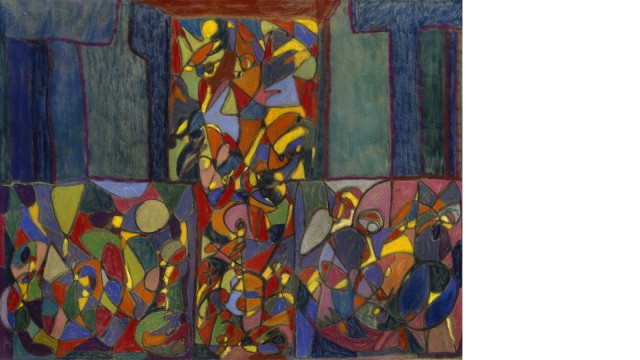
Biography
Adolf Hölzel (1853–1934): Born in Olomuc (Moravia), he completed an apprenticeship as a typesetter in the German city of Gotha. In 1871, his family relocated to Vienna and Hölzel enrolled at the Akademie der bildenden Künste Wien as a visiting student. In 1876, he moved to Munich and started studying art at the Akademie der Bildenden Künste München. From 1879 to 1882, he was a master student under Wilhelm von Diez, one of the few genre painters at an academy that was regarded as the European center of history painting at that time. In 1887, he embarked on his first educational trip to Paris together with Arthur Langhammer. That same year, he relocated to Dachau, near Munich. In 1892, he co-founded the private “Dachauer Malschule” and subsequently formed the “Neu-Dachauer Malergruppe” together with Arthur Langhammer and Ludwig Dill, which was inspired by the French “Barbizon school” and its anti-academicism and concept of the ‘paysage intime.’ That same year, the “Münchner Secession”, co-founded by Hölzel, broke away from the “Münchner Künstlergenossenschaft”. He was also a member of the “Vereinigung Bildender Künstler Österreichs” and published his first essay on art theory in its magazine “Ver Sacrum” in 1901. In 1905, he was appointed professor of the composition class at the “Kgl. Akademie der Bildenden Künste” (now “Staatliche Akademie der Bildenden Künste Stuttgart”). In 1907, he met Paul Sérusier, who was a member of the “Les Nabis” group surrounding Paul Gauguin. In 1910, he completed a crucifixion mural entitled “Der Gekreuzigte” in the Ulm Garnisonskirche built by Theodor Fischer (now Paulskirche); the mural was partially painted over in the 1960s. Ida Kerkovius, who had already attended classes in Dachau, became his assistant in 1911. The “Hölzel circle” formed and was manifested in 1916 with an exhibition at the “Freiburger Kunstverein”. In 1914, he created the first glass windows for the boardroom of the Bahlsen factory in Hanover. He held the position of director of the Stuttgart academy from 1916 to 1918. In 1918, he held his first major solo exhibition at the Kestner-Gesellschaft in Hanover. Fritz Beinhoff, counsel and owner of the Günther Wagner company, Pelikan-Werke, purchased all the exhibits that were on display. Hölzel left the Stuttgart academy in 1919. In 1927, he started teaching at the “Freie Kunstschule” in Stuttgart, which was founded by his student August Ludwig Schmitt. He created glass windows for Stuttgart city hall in 1928–1929, for the Pelikan factory in Hanover in 1932–1933, and for the J.F. Maercklin company in 1934. Due to the seizure of power by the National Socialists in 1933, the large-scale survey exhibition on “Hölzel und sein Kreis” that was to take place in Stuttgart as part of the “Landeskunstausstellung” was canceled.
